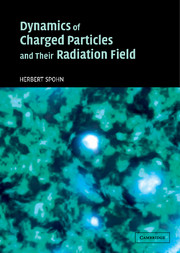Book contents
- Frontmatter
- Contents
- Preface
- List of symbols
- 1 Scope, motivation, and orientation
- Part I Classical theory
- 2 A charge coupled to its electromagnetic field
- 3 Historical notes
- 4 The energy–momentum relation
- 5 Long-time asymptotics
- 6 Adiabatic limit
- 7 Self-force
- 8 Comparison dynamics
- 9 The Lorentz–Dirac equation
- 10 Spinning charges
- 11 Many charges
- 12 Summary and preamble to the quantum theory
- Part II Quantum Theory
- References
- Index
2 - A charge coupled to its electromagnetic field
Published online by Cambridge University Press: 14 August 2009
- Frontmatter
- Contents
- Preface
- List of symbols
- 1 Scope, motivation, and orientation
- Part I Classical theory
- 2 A charge coupled to its electromagnetic field
- 3 Historical notes
- 4 The energy–momentum relation
- 5 Long-time asymptotics
- 6 Adiabatic limit
- 7 Self-force
- 8 Comparison dynamics
- 9 The Lorentz–Dirac equation
- 10 Spinning charges
- 11 Many charges
- 12 Summary and preamble to the quantum theory
- Part II Quantum Theory
- References
- Index
Summary
We plan to study the dynamics of a well-localized charge, like an electron or a proton, when coupled to its own electromagnetic field. The case of several particles is reserved for chapter 11. In a first attempt, one models the particle as a point charge with a definite mass. If its world line is prescribed, then the fields are determined through the inhomogeneous Lorentz–Maxwell equations. On the other hand, if the electromagnetic fields are given, then the motion of the point charge is governed by Newton's equation of motion with the Lorentz force as force law. While it then seems obvious how to marry the two equations, such as to have a coupled dynamics for the charge and its electromagnetic field, ambiguities and inconsistencies arise due to the infinite electrostatic energy of the Coulomb field of the point charge. Thus one is forced to introduce a slightly smeared charge distribution, i.e. an extended charge model. Mathematically this means that the interaction between particle and field is cut off or regularized at short distances, which seems to leave a lot of arbitrariness. There are also strong constraints, however. In particular, local charge conservation must be satisfied, the theory should be of Lagrangian form, and it should reproduce the two limiting cases mentioned already. In addition, as expected from any decent physical model, the theory should be well defined and empirically accurate within its domain of validity. In fact, up to the present time only two models have been worked out in some detail: (i) the semirelativistic Abraham model of a rigid charge distribution; and (ii) the Lorentz model of a relativistically covariant extended charge distribution.
- Type
- Chapter
- Information
- Publisher: Cambridge University PressPrint publication year: 2004



